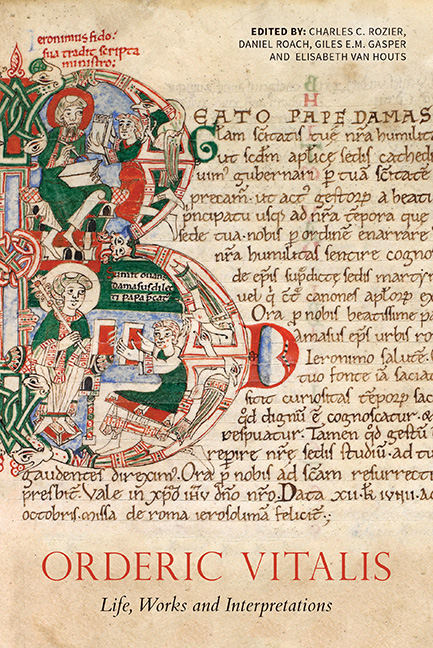Book contents
- Frontmatter
- Dedication
- Contents
- List of Illustrations
- Acknowledgements
- List of Abbreviations
- Chronology of the Lives of Odelerius and his Son Orderic Vitalis
- Composition of the Historia ecclesiastica
- Introduction: Interpreting Orderic Vitalis
- Orderic and his Father, Odelerius
- Following the Master's Lead: The Script of Orderic Vitalis and the Discovery of a New Manuscript (Rouen, BM, 540)
- Orderic Vitalis as Librarian and Cantor of Saint-Évroul
- Saint-Évroul and Southern Italy in Orderic's Historia ecclesiastica
- Orderic and English
- Inscriptions in Orderic's Historia ecclesiastica: A Writing Technique between History and Poetry
- Reading Orderic with Charters in Mind
- Orderic Vitalis and the Cult of Saints
- Orderic's Secular Rulers and Representations of Personality and Power in the Historia ecclesiastica
- Worldly Woe and Heavenly Joy: The Tone of the Historia ecclesiastica
- Orderic Vitalis, Historical Writing and a Theology of Reckoning
- Jesus Christ, a Protagonist of Anglo-Norman History? History and Theology in Orderic Vitalis's Historia ecclesiastica
- ‘Studiosi abdita investigant’: Orderic Vitalis and the Mystical Morals of History
- Meanders, Loops, and Dead Ends: Literary Form and the Common Life in Orderic's Historia ecclesiastica
- Orderic and the Tironensians
- ‘One single letter remained in excess of all his sins …’: Orderic Vitalis and Cultural Memory
- The Reception of Orderic Vitalis in the Later Middle Ages
- Appendix 1 Archaeological Investigations at the Abbey of Saint-Évroult-Notre-Dame-des-Bois
- Appendix 2 Descriptive Catalogue of Manuscripts Featuring the Hand of Orderic Vitalis
- Select Bibliography
- List of Manuscripts Cited
- General Index
Meanders, Loops, and Dead Ends: Literary Form and the Common Life in Orderic's Historia ecclesiastica
Published online by Cambridge University Press: 25 October 2017
- Frontmatter
- Dedication
- Contents
- List of Illustrations
- Acknowledgements
- List of Abbreviations
- Chronology of the Lives of Odelerius and his Son Orderic Vitalis
- Composition of the Historia ecclesiastica
- Introduction: Interpreting Orderic Vitalis
- Orderic and his Father, Odelerius
- Following the Master's Lead: The Script of Orderic Vitalis and the Discovery of a New Manuscript (Rouen, BM, 540)
- Orderic Vitalis as Librarian and Cantor of Saint-Évroul
- Saint-Évroul and Southern Italy in Orderic's Historia ecclesiastica
- Orderic and English
- Inscriptions in Orderic's Historia ecclesiastica: A Writing Technique between History and Poetry
- Reading Orderic with Charters in Mind
- Orderic Vitalis and the Cult of Saints
- Orderic's Secular Rulers and Representations of Personality and Power in the Historia ecclesiastica
- Worldly Woe and Heavenly Joy: The Tone of the Historia ecclesiastica
- Orderic Vitalis, Historical Writing and a Theology of Reckoning
- Jesus Christ, a Protagonist of Anglo-Norman History? History and Theology in Orderic Vitalis's Historia ecclesiastica
- ‘Studiosi abdita investigant’: Orderic Vitalis and the Mystical Morals of History
- Meanders, Loops, and Dead Ends: Literary Form and the Common Life in Orderic's Historia ecclesiastica
- Orderic and the Tironensians
- ‘One single letter remained in excess of all his sins …’: Orderic Vitalis and Cultural Memory
- The Reception of Orderic Vitalis in the Later Middle Ages
- Appendix 1 Archaeological Investigations at the Abbey of Saint-Évroult-Notre-Dame-des-Bois
- Appendix 2 Descriptive Catalogue of Manuscripts Featuring the Hand of Orderic Vitalis
- Select Bibliography
- List of Manuscripts Cited
- General Index
Summary
This chapter considers the literary forms of Orderic Vitalis's Historia ecclesiastica as a way to think about the relationship between identity, history-writing and the practice of the monastic common life during the early twelfth century. Anne L. Clark has characterised medieval monastic practice in general as the process of ‘dismantling of the autonomous person’ and ‘the reconstruction of that being into a member […] [of] the monastic community itself ’. Without denying the Historia's place within political discourse or its powerful administrative and economic motivations, I will situate the text's form within eleventh- and twelfth-century discussions of this transition from a secular individual to a member of a monastic community. In doing so, I wish to suggest not only the sensitive artistry of Orderic's style but also its foundations in the rhetoric and practices of the monastic common life.
Orderic has usually been overlooked as an artist. Some of this neglect stems from the Historia's Norman provenance and its Latin language, both of which place the work in an odd relation to the literary histories of both Britain and France. The Historia's breadth and shape can be dismaying as well, for Orderic frequently challenges the reader's expectations about how rhetorical history should sound and what it should be about. He is given to digressions, and he frequently interrupts himself by inserting into the Historia verse epitaphs, occasional poems, saints’ lives, charters, miracles, local histories, genealogies, misogynist gossip, a whole history of the First Crusade lifted from Baldric of Bourgueil, and (seemingly) whatever has come into his head at any given moment. For example, in Book III, where Orderic discusses the foundation of Saint-Évroul in 1050, he begins with a potted history of Normandy from the Merovingian age, moves on to discuss the foundation of Le Bec, then makes a feint at the foundation of Saint-Évroul but gets distracted by a genealogy of the Giroie family from the tenth century onwards, and then by extended stories of supernatural punishments visited upon unworthy clerics. Orderic finally returns to the foundation of the community itself by copying out a pancarte from the monastery's archive, but in order to make sense of this he must launch into a dynastic history of the Norman dukes, and so gets swept away describing the conquest of England in 1066.
- Type
- Chapter
- Information
- Orderic Vitalis: Life, Works and Interpretations , pp. 298 - 323Publisher: Boydell & BrewerPrint publication year: 2016



